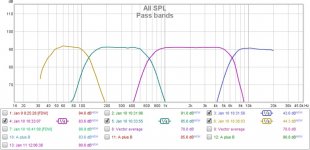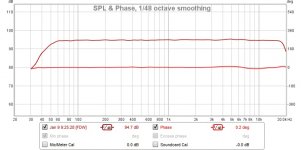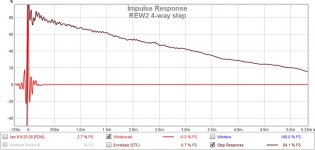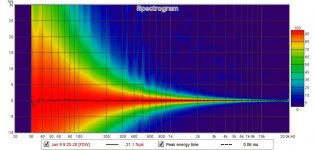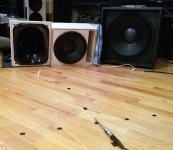Flat on what axis, or axes?
Meh, sure you can use DSP to make the frequency response perfectly flat, whether only by crossover filter function or with EQ as well. See for example the Ultimate Equalizer by Bodzio Software. It's no problem to do this now.
The real question is whether you have made the loudspeaker "better". While the frequency response can be made perfectly flat on one axis, you do this by adjusting the input power (EQ-ing) across the frequency band. This will influence all frequencies in the same way. The result is that you have made only one axis "flat" and probably screwed up the response (made it worse) on most other axes. That is no improvement!
This is one reason why a loudspeaker with a dipole radiation pattern is very intriguing. If carefully designed, it will have nearly the same frequency response on ALL axes, at least much more than other types of loudspeaker systems. In that case you can equalize one axis (e.g. forward, towards the listener) and all axes will be equalized in more or less the same way. It also makes it possible to listen to the loudspeaker far off axis, and the tonal balance will remain pretty much the same. These are some of the reasons why this type of loudspeaker is all that I try to design and build these days.
It is also possible to have a similar effect with certain horn loaded systems, as long as the directivity remains nearly constant. The problem is that this is really not possible below about 500Hz, because pretty much all direct-radiators in a box become a monopole below that frequency. The best you can hope to achieve is a smoothly CHANGING directivity of this type of loudspeaker, and that is not really as good as the dipole, which can have essentially flat directivity and power response over a very wide frequency range approaching the full audio spectrum, 20-20k.
Meh, sure you can use DSP to make the frequency response perfectly flat, whether only by crossover filter function or with EQ as well. See for example the Ultimate Equalizer by Bodzio Software. It's no problem to do this now.
The real question is whether you have made the loudspeaker "better". While the frequency response can be made perfectly flat on one axis, you do this by adjusting the input power (EQ-ing) across the frequency band. This will influence all frequencies in the same way. The result is that you have made only one axis "flat" and probably screwed up the response (made it worse) on most other axes. That is no improvement!
This is one reason why a loudspeaker with a dipole radiation pattern is very intriguing. If carefully designed, it will have nearly the same frequency response on ALL axes, at least much more than other types of loudspeaker systems. In that case you can equalize one axis (e.g. forward, towards the listener) and all axes will be equalized in more or less the same way. It also makes it possible to listen to the loudspeaker far off axis, and the tonal balance will remain pretty much the same. These are some of the reasons why this type of loudspeaker is all that I try to design and build these days.
It is also possible to have a similar effect with certain horn loaded systems, as long as the directivity remains nearly constant. The problem is that this is really not possible below about 500Hz, because pretty much all direct-radiators in a box become a monopole below that frequency. The best you can hope to achieve is a smoothly CHANGING directivity of this type of loudspeaker, and that is not really as good as the dipole, which can have essentially flat directivity and power response over a very wide frequency range approaching the full audio spectrum, 20-20k.
Last edited:
The problem is that this is really not possible below about 500Hz,
Yes, you can make speakers FLAT if they are well designed, or you have Room EQ, but ... do you actually like FLAT sounding speakers (referring to response, not the general sound).
Many even high quality speakers have a Bass Bump in them ...why?... because people like bass. Also because that the same measured volume level, different frequencies don't sound the same perceived loudness. High Frequencies tend to sound louder at the same measured volume.
Rather that trying to achieve some theoretical standard, try to buy or build speakers that you like.
What you really want from a speaker, is that no particular frequencies stand out in an unbalanced and noticeable way. You don't want the speaker to be flat, you want to perceive it as sounding flat and balanced even if it is not technically flat.
Then we have the matter of DEEP personal taste. I can't tell you how many systems I've encountered in people's home where the Bass and Treble are cranked to the MAX. Fine, I'm OK with that; if the user is happy then I am happy.
There are the old style Graphic EQ devices, though today this is mostly don't in electronics and software. But a mutli-slider Graphic EQ is only of value if you have some way of testing the room response so you know what specifically needs to be EQ'd. A vast majority (virtually ALL) people I've encountered that had a Graphic EQ simply used it as an extension of the volume control.
Further, let's not try to use EQ to compensate for an acoustically BAD Room. Good EQ can make a good room better, but it simply can NOT make a Bad Room Good. If you are having problems with your sound, then you need to dump some common sense and some money into the room itself.
So, in summary, buy or build speakers you like the sound of, and forget the technical details.
But then ... that's just my opinion.
Steve/bluewizard
Many even high quality speakers have a Bass Bump in them ...why?... because people like bass. Also because that the same measured volume level, different frequencies don't sound the same perceived loudness. High Frequencies tend to sound louder at the same measured volume.
Rather that trying to achieve some theoretical standard, try to buy or build speakers that you like.
What you really want from a speaker, is that no particular frequencies stand out in an unbalanced and noticeable way. You don't want the speaker to be flat, you want to perceive it as sounding flat and balanced even if it is not technically flat.
Then we have the matter of DEEP personal taste. I can't tell you how many systems I've encountered in people's home where the Bass and Treble are cranked to the MAX. Fine, I'm OK with that; if the user is happy then I am happy.
There are the old style Graphic EQ devices, though today this is mostly don't in electronics and software. But a mutli-slider Graphic EQ is only of value if you have some way of testing the room response so you know what specifically needs to be EQ'd. A vast majority (virtually ALL) people I've encountered that had a Graphic EQ simply used it as an extension of the volume control.
Further, let's not try to use EQ to compensate for an acoustically BAD Room. Good EQ can make a good room better, but it simply can NOT make a Bad Room Good. If you are having problems with your sound, then you need to dump some common sense and some money into the room itself.
So, in summary, buy or build speakers you like the sound of, and forget the technical details.
But then ... that's just my opinion.
Steve/bluewizard
Last edited:
Yes, you can make speakers FLAT if they are well designed, or you have Room EQ, but ... do you actually like FLAT sounding speakers (referring to response, not the general sound).
Many even high quality speakers have a Bass Bump in them ...why?... because people like bass. Also because that the same measured volume level, different frequencies don't sound the same perceived loudness. High Frequencies tend to sound louder at the same measured volume.
Rather that trying to achieve some theoretical standard, try to buy or build speakers that you like.
What you really want from a speaker, is that no particular frequencies stand out in an unbalanced and noticeable way. You don't want the speaker to be flat, you want to perceive it as sounding flat and balanced even if it is not technically flat.
Then we have the matter of DEEP personal taste. I can't tell you how many systems I've encountered in people's home where the Bass and Treble are cranked to the MAX. Fine, I'm OK with that; if the user is happy then I am happy.
There are the old style Graphic EQ devices, though today this is mostly don't in electronics and software. But a mutli-slider Graphic EQ is only of value if you have some way of testing the room response so you know what specifically needs to be EQ'd. A vast majority (virtually ALL) people I've encountered that had a Graphic EQ simply used it as an extension of the volume control.
Further, let's not try to use EQ to compensate for an acoustically BAD Room. Good EQ can make a good room better, but it simply can NOT make a Bad Room Good. If you are having problems with your sound, then you need to dump some common sense and some money into the room itself.
So, in summary, buy or build speakers you like the sound of, and forget the technical details.
But then ... that's just my opinion.
Steve/bluewizard
You blew me away with that response

the reasoning behind my hypohetical flat speaker been built wihout EQ is that personal taste can be tailored at any frequency or house curve implemented (by reduction of EQ but not bumped up)
Last edited:
Because they are usually resonant and they're tuned that way......ok because people like it, but also because it's a way of getting cheap bass extensionMany even high quality speakers have a Bass Bump in them ...why?...
Flat on what axis, or axes?
Meh, sure you can use DSP to make the frequency response perfectly flat, whether only by crossover filter function or with EQ as well. See for example the Ultimate Equalizer by Bodzio Software. It's no problem to do this now.
The real question is whether you have made the loudspeaker "better". While the frequency response can be made perfectly flat on one axis, you do this by adjusting the input power (EQ-ing) across the frequency band. This will influence all frequencies in the same way. The result is that you have made only one axis "flat" and probably screwed up the response (made it worse) on most other axes. That is no improvement!
Could not agree more !!!!
For illustration of how easy it is to tune almost perfectly to a SPOT, check out the graphs below. Shameless tuning of a 4-way proto to a single SPOT.....
First graph is the passbands...those are driver response, not electrical !
Second, mag and phase of the full 4-way.
Third, impulse and step.
Last, spectogram....
They look good to me, but they mean nothing...unless they hold up off axis... I mean, for heavens sake look at the rig setup....what's the odds of off axis looking good ? lol
Attachments
Flat frequency speaker has been developed
OK not strictly true
But if it was by using dsp for xover functions only and not for equalizaiton.
Could it be equed for personal taste and any given room size (wihin reason)
Have been doing that with each of my systems. There is lot more to it than flat fr response.
What about phase?
Well you may be able to eq. flat frequency response, but you in the process introduce unwanted phase-shift and mess up the time domain response. The more complicated xover, the more likely you'll have ringing in the time domain.
Besides I don't think flat frequency response is ideal to start with. I actually don't think our ears want flat frequency response from speakers.
Besides I don't think flat frequency response is ideal to start with. I actually don't think our ears want flat frequency response from speakers.
Because they are usually resonant and they're tuned that way......ok because people like it, but also because it's a way of getting cheap bass extension
I can't (and won't) argue that point. But outside of production studios, why is it that people like Not-Flat speakers?
Also, flat where, and by that I mean if the are flat in a anechoic chamber, they are probably not going to be flat in your room.
Of course, in room, you have Room EQ, but does Room EQ improve an existing good room, or is it a desperate attempt to make right a clearly bad room?
Also, though anecdotal, many people use Room EQ for Movies, but turn it off for Muisic because they feel the music sounds better. To each his own, but that implies something.
Rather than searching for a technical standard, get speakers that you like the sound of. That's all I'm saying. Even speakers that you like the sound of could probably still do with some Room EQ, but that is not to change the speaker, rather it is to correct the room.
Steve/bluewizard
Well you may be able to eq. flat frequency response, but you in the process introduce unwanted phase-shift and mess up the time domain response. The more complicated xover, the more likely you'll have ringing in the time domain.
Besides I don't think flat frequency response is ideal to start with. I actually don't think our ears want flat frequency response from speakers.
Hi Andy, my take.............
You're making many assumptions than IME don't hold true with frequency and phase response. IME, mag right = phase right.
Whether we like how our our system sounds flat or not depends more on how it was recorded than anything else.....assuming our system is flat
Last edited:
I think most rooms are too small for the levels people listen at, turning the volume down can reduce many room induced problemsOf course, in room, you have Room EQ, but does Room EQ improve an existing good room, or is it a desperate attempt to make right a clearly bad room?
Many even high quality speakers have a Bass Bump in them ...why?... because people like bass.
Witness overcooked BSC filters, flattening the on-axis and bumping up the power response at the same time.
dave
The reasons I became interested in dipole speakers were, radiation pattern, room interaction, lack of box resonances etc....the usual.....This is one reason why a loudspeaker with a dipole radiation pattern is very intriguing. If carefully designed, it will have nearly the same frequency response on ALL axes, at least much more than other types of loudspeaker systems. In that case you can equalize one axis (e.g. forward, towards the listener) and all axes will be equalized in more or less the same way. It also makes it possible to listen to the loudspeaker far off axis, and the tonal balance will remain pretty much the same. These are some of the reasons why this type of loudspeaker is all that I try to design and build these days.
After living with them for a while and experimenting with positioning to get the desired reflections etc I found I enjoyed the wide, almost lack of, sweet spot. This got me thinking about omnidirectional speakers and whether I'd enjoy them even more. I've held off though because it would mean some kind of enclosure, so I find your post interesting since as I move around the room I find the set-up I have is almost omnidirectional.
EQ can help a lot to get the desired sound of any speaker, it's basic response curve is irrelevant (unsell it shows sharp dicontinuities that tell about major problems). But if speaker has problems in directivity and room interaction, task is too much asked.
To get desired sound with nice spectral balance, use low Q adjustments, 1-½octave bands and don't use measurement mic but just listen!
If you then measure RTA response at listening spot, I bet that it is not flat !
To get desired sound with nice spectral balance, use low Q adjustments, 1-½octave bands and don't use measurement mic but just listen!
If you then measure RTA response at listening spot, I bet that it is not flat !
Last edited:
Could not agree more !!!!
For illustration of how easy it is to tune almost perfectly to a SPOT, check out the graphs below. Shameless tuning of a 4-way proto to a single SPOT.....
First graph is the passbands...those are driver response, not electrical !
Second, mag and phase of the full 4-way.
Third, impulse and step.
Last, spectogram....
They look good to me, but they mean nothing...unless they hold up off axis... I mean, for heavens sake look at the rig setup....what's the odds of off axis looking good ? lol
Hi mark
That looks pretty horrible to me
Typical modern noob playing on the phase. A dangerous tool to give into peoples hands who think you can EQ phase like the magnitude to a flat line.
Look at the IR ringing, the bass is 10-20ms ahead of peak. The drums will sound horrible distorted like a synthi
Of course this is nicely hidden away on the step response
The perfect ideal phase of a speaker is not flat !
Its causal according minimum phase.
Let alone the huge Y-axis scale of magnitude, with 1/6oct smoothing its not a revolution. Nevertheless, thats ideal to start with for designing properly merging XO. The tilting & room-eq comes on the complete system afterwards on top. EQ as odd as u like, but the single drivers need to cooperate linear into a flat sum. Otherwise they wont merge into one harmonic coherent point. Thats what most fullrange-users complain about. That guy wont have any incoherence issues.
But lot of different ones
cheers
Josh
Last edited:
Hi mark
That looks pretty horrible to me
Typical modern noob playing on the phase. A dangerous tool to give into peoples hands who think you can EQ phase like the magnitude to a flat line.
Look at the IR ringing, the bass is 10-20ms ahead of peak. The drums will sound horrible distorted like a synthi
Of course this is nicely hidden away on the step response
The perfect ideal phase of a speaker is not flat !
Its causal according minimum phase.
cheers
Josh
Hi Josh, fun !
Quick question...where/how do you see bass is 10-20ms ahead of peak?
OK, perfect ideal phase of a speaker?
Well, IMO we should start with what we think the perfect speaker is...
...which I think would be one full range driver extending beyond audibility both ends
...which I believe the textbooks say would have flat phase..
I don't know what to think yet about minimum phase roll off down low.
I know if a real life kick drum gets whacked....it's the initial rise of all frequencies that have to be in sync...which is linear phase.
I know with kick drum playback thru causal minimum phase, that bottom end phase roll-off will make higher freqs arrive earlier than low...group delay.
This seems like bad timing to me.
I know people talk about bass pre-ringing when deviating from minimum phase...
...yet minimum phase could also be thought of as high freq pre-arrival.
Which is worse? I dunno... I do know when I experiment with this I can't begin to tell indoors for all the known room interaction reasons.
Outdoors I keep leaning to flat phase all the way down...
Cheers indeed, mark
I can't (and won't) argue that point. But outside of production studios, why is it that people like Not-Flat speakers?
All the commercial recordings are mastered for "average home listening environment" which is a bit bass heavy. If you have a flat response speaker made for some kind of lab work, all of them should sound different from what was intended.
Last edited:
- Status
- This old topic is closed. If you want to reopen this topic, contact a moderator using the "Report Post" button.
- Home
- Loudspeakers
- Multi-Way
- Flat frequency response speaker has been developed
